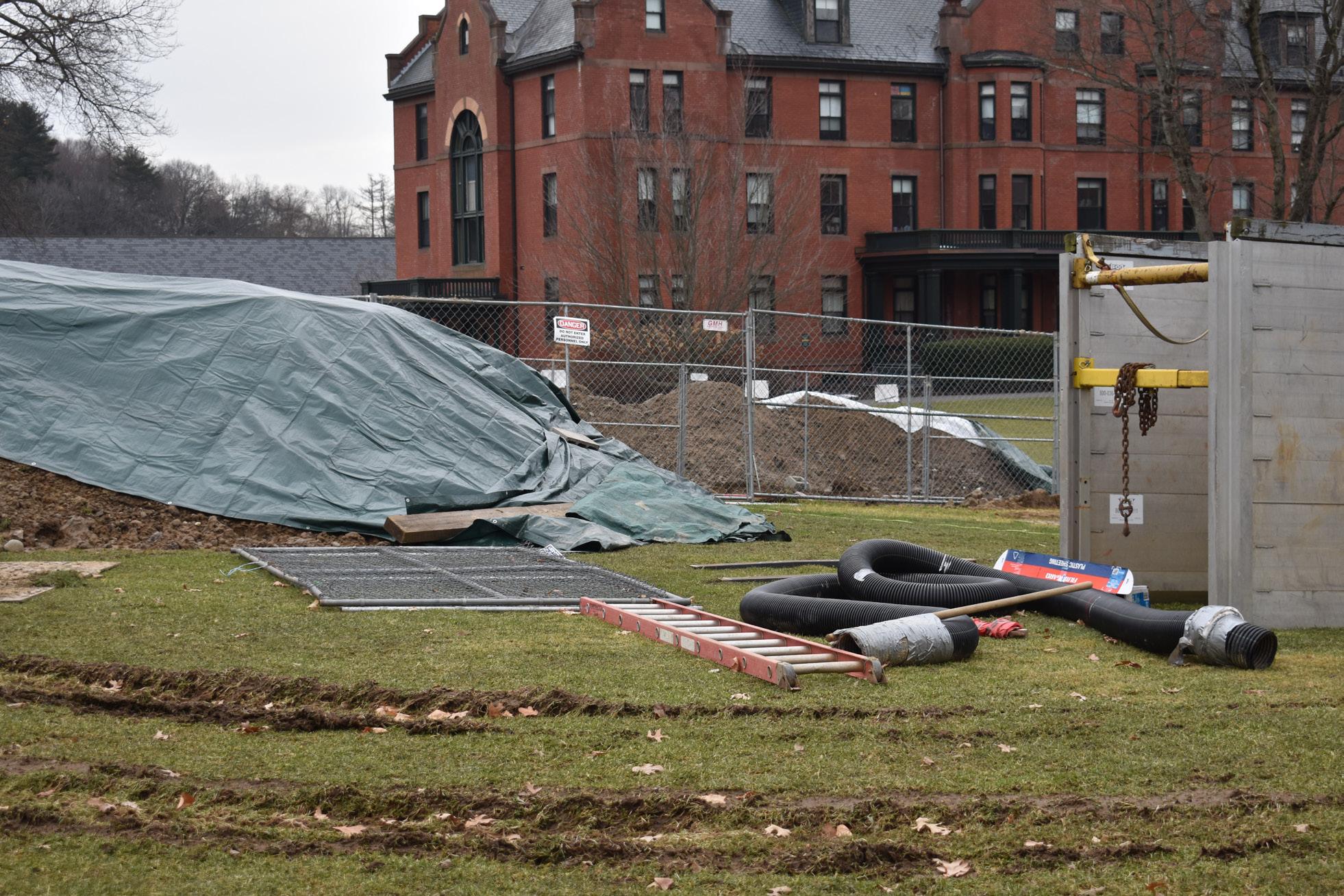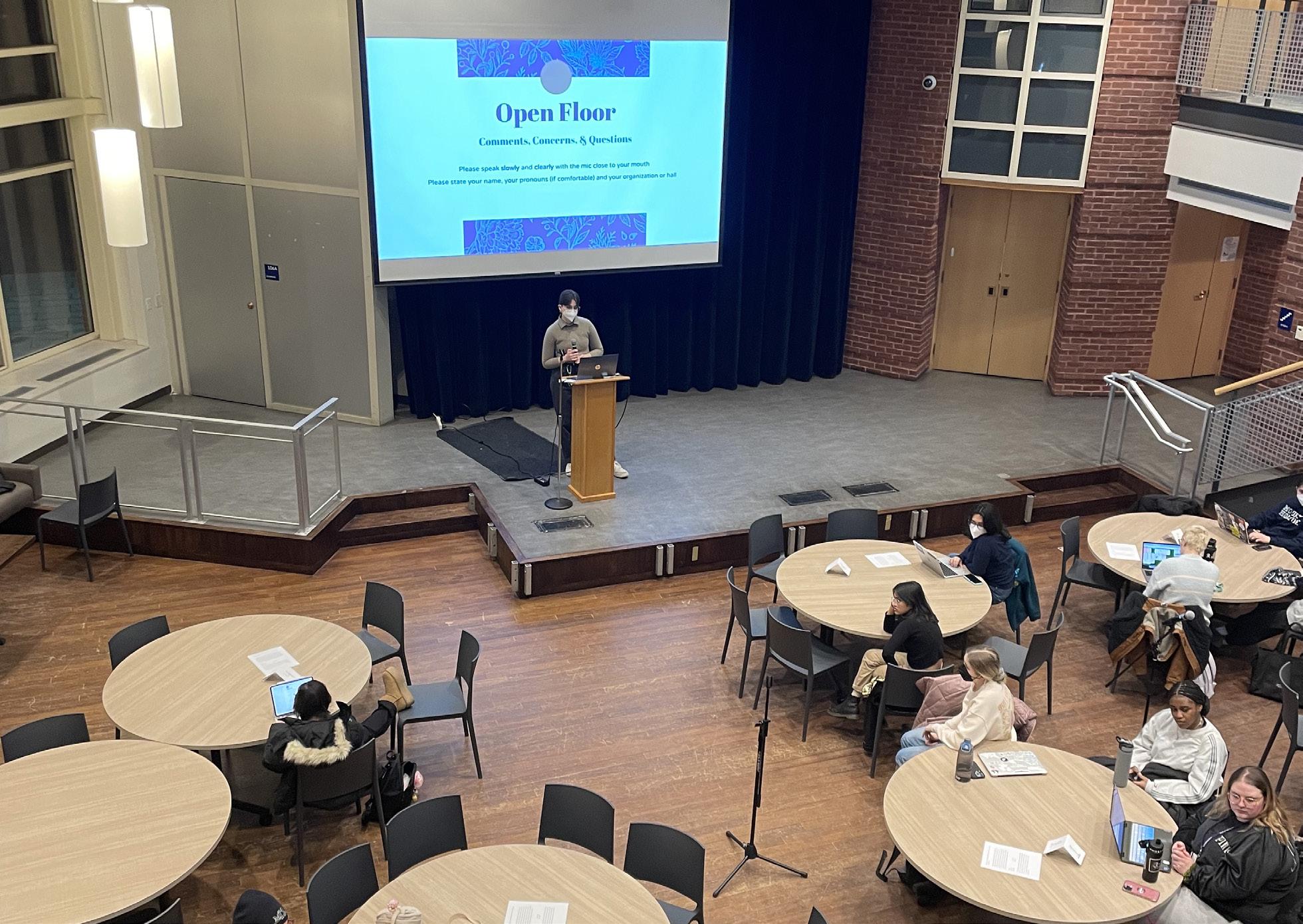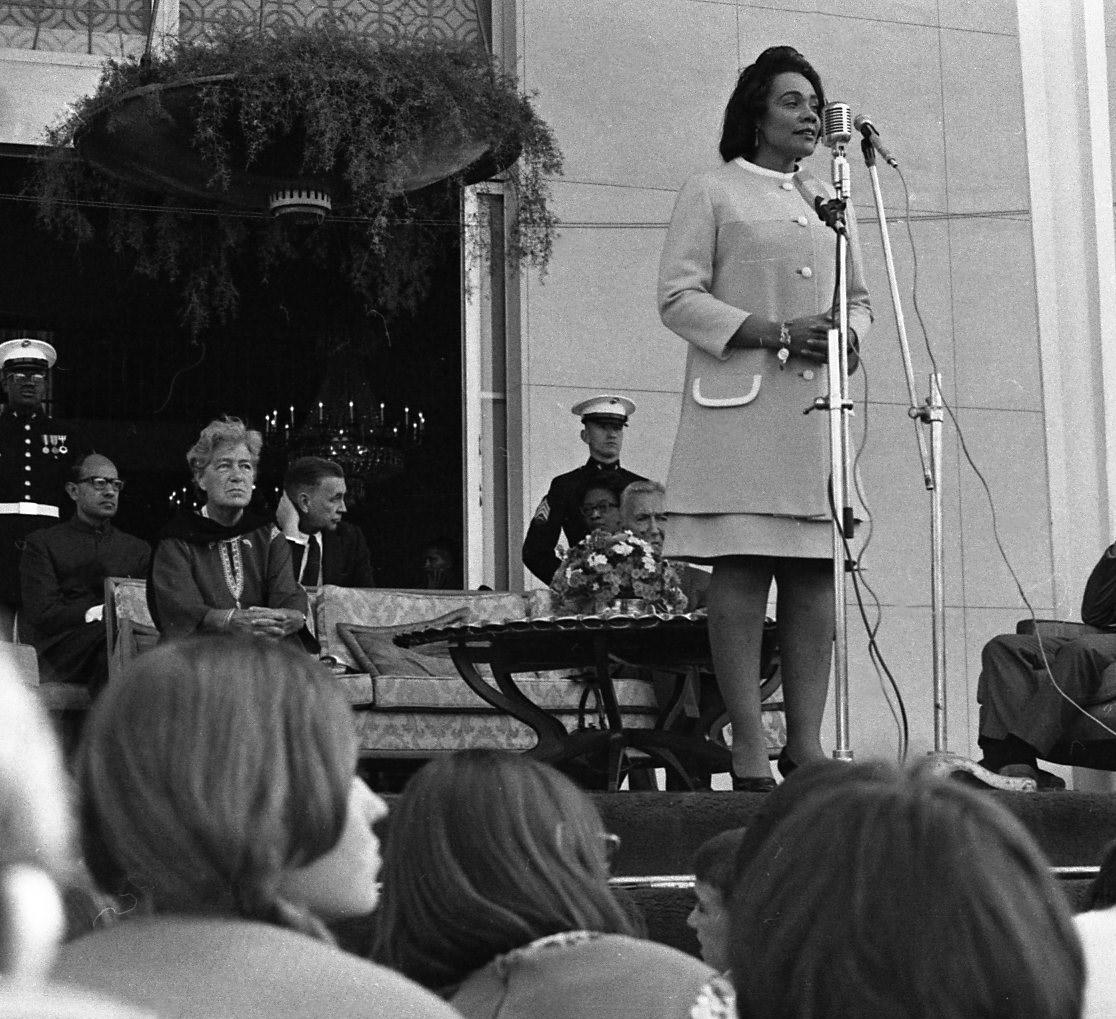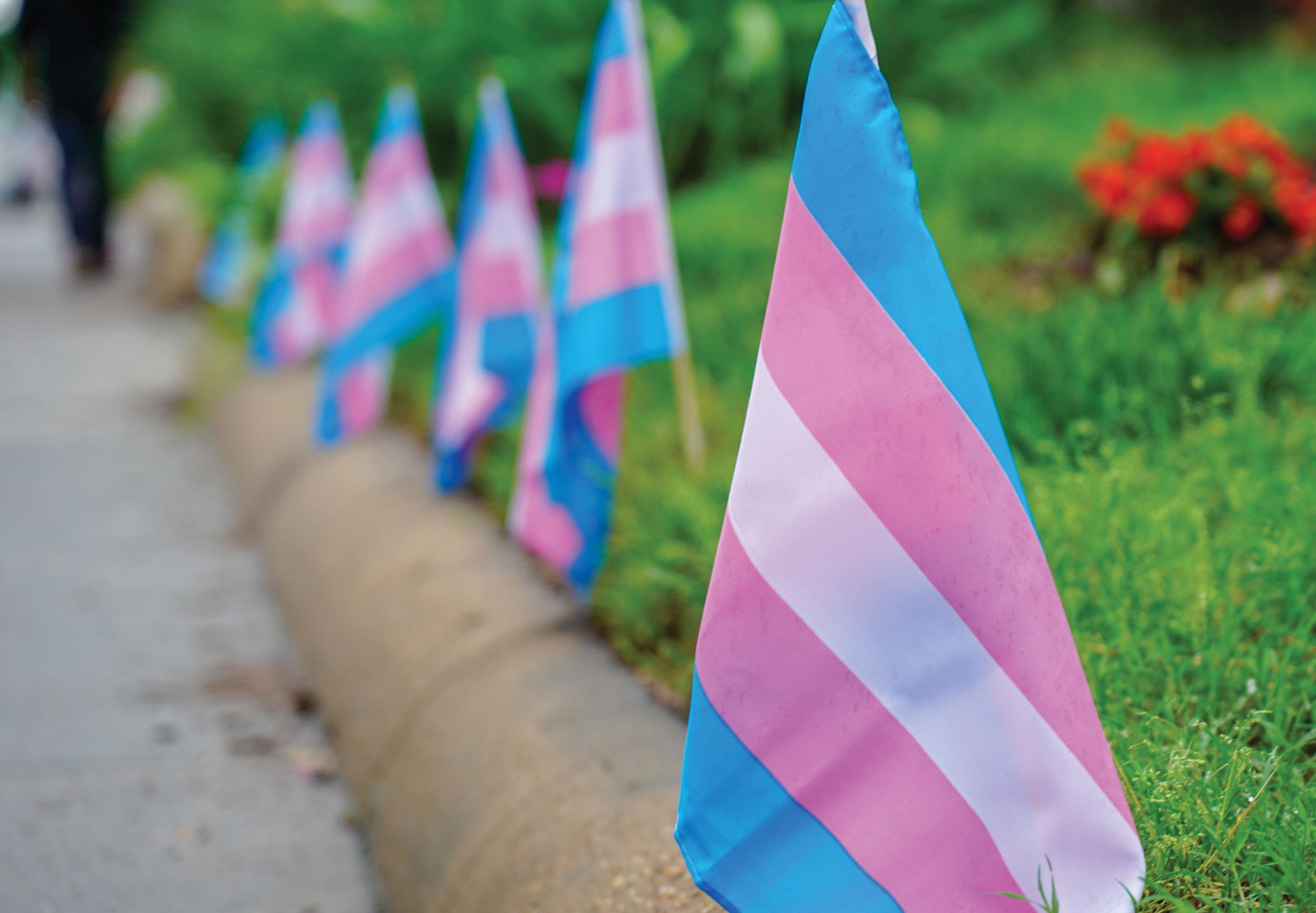Mount Holyoke News
AN INDEPENDENT STUDENT NEWSPAPER SINCE 1917
FRIDAY, FEBRUARY 3, 2023

FRIDAY, FEBRUARY 3, 2023
When students returned to campus on the weekend of Jan. 21, they were greeted by large piles of dirt and a wire fence with signs warning of danger surrounding a pit in the ground at the center of Skinner Green. Facilities Management began this excavation process due to a leak in the steam line that runs beneath the green.

Throughout the day, workers were seen driving a van back and forth with supplies over pads placed on top of the Green’s muddy surface. At the end of January, the center of the excavation site contains two thin pipes, one green and one gray, overlapping a much thicker pipe and a blue rod sticking into one of the tubes.
Karla Youngblood FP ’99, Associate Vice President of Facilities Management, confirmed in an email to Mount Holyoke News that the steam line that runs across Skinner Green developed a leak on Jan. 18 at approximately 10 a.m., the move-in day for new domestic students. In order to work on the leak, Facilities Management had to submit a Dig Safe permit to the state.
The pipes under Skinner Green are part of the Central Heating Plant that heats the entire campus. According to the College’s website, the plant burns 6,500 gallons of #6 Fuel Oil daily during peak use. On Tuesday, Jan. 24, the heat was turned
off in Skinner Hall in order to work on the leak. Youngblood stated that during this time, Skinner was able to stay warm due to residual heat.
Early in the excavation, a Facilities Management worker sustained severe burns onsite. Per Raymond LaBarre, the Director of Public Safety and Service, Public Safety and
local emergency personnel were called. According to a student worker who wished to remain anonymous, the injury occurred when a worker fell into the pit and the standing water around the pipes. The pipes are directly connected to the heating system, so the water was “nearly boiling,” according to the student.
This would be an Occupational Safety and Health Administration (OSHA) violation under 1926.651(h) (1) which states that employees are not allowed to work in accumulated water without proper protection. According to the student, two additional workers were needed to help the burned worker out of the pit.
The College released a statement to the News in reaction to campus concern, writing that “Mount Holyoke is committed to the health and safety of all of its employees. We are fortunate that workplace accidents are rare. When an accident does occur, the College does whatever it can to assist the injured employee and take steps to prevent future accidents.” They confirmed that the excavation site has been secured since the injury. The administration did not answer any further questions, citing the need to preserve the employee’s privacy.
On Jan. 30, after Mount Holyoke News began inquiring about the injuries incurred, the school sent out a statement to students. “We were recently in contact with staff and faculty to notify them that we are aware of an accident that occurred on Skinner Green a couple of weeks ago. Please know that the area has since been secured and the employee is receiving treatment and community support.
In order to respect the privacy of the injured person, it is the College’s practice not to identify the individual. We want to thank everyone for their concern. As always, we encourage everyone to be mindful of your surroundings.”
The steam line was repaired on Jan. 28 and 29. The site was refilled by Feb 2.
Individual Facilities Management workers declined requests to comment.
On Jan. 31, the Student Government Association opened its first senate meeting of the semester with a greeting to all the members, welcoming them back after the break. Following the reading of the agenda and the land acknowledgment, the meeting began with E-board updates.
First, it was announced that during the spring semester, SGA Senate will be hosting several town halls in addition to their regular meetings. The guests and dates of these meetings are to be determined.
Second, SGA President, Maille Romulus ’24, discussed the binder drive, which occurred on the evening of Jan. 27. In total, the SGA was able to order 33 out of the 70 binders requested. The deficit was due to several binders being out of stock, but the binders that were not able to be ordered will be ordered with a slight delay. The first 33 binders should be arriving soon.
Senate closed E-board updates by discussing the latest issue of the Newsflush, to be distributed to the hall senators. Newsflushes should
be posted in all residence hall bathrooms.
The senate then moved onto the open floor, where senators and representatives were welcomed to introduce themselves and their organizations or halls and to give announcements or bring up concerns.
During the updates and announcements portion of the open floor, several students promoted upcoming events and deadlines. A member of the board of the class of 2025 brought up their upcoming Valentine’s Masquerade Ball, to be held on Feb. 10 in the Great Room from 8-11 p.m.
A member of the class board for 2024 announced that they were still looking for actors and crew for J-Show. The link to sign up was sent out in an email on Feb. 1.
Finally, an E-board member speaking on behalf of Residential Life reminded everyone that RA and orientation leader applications are due Feb. 12. More information about those applications can be found on Embark or on the TVs around the Student Center.
 BY ANOUSHKA KUSWAHA ’24 NEWS EDITOR
BY ANOUSHKA KUSWAHA ’24 NEWS EDITOR
Content warning: This article discusses gun violence, mass death, murder and suicide.
As of Feb. 2, approximately 54 mass shootings have already taken place in 2023 in the U.S. The most destructive mass shooting of the year so far occurred in Monterey Park, CA, resulting in the deaths of 11 victims and the injury of nine others.
On Jan. 21, a man opened fire at approximately 10:30 p.m. PT in the Star Ballroom Dance Studio. The shooter then attempted to open fire in the nearby Lai Lai Ballroom & Studio in Alhambra, CA, according to the Los Angeles Times.
The shooting took place on the eve of the Lunar New Year, one of the largest holiday events in the
area, during which members of the community gathered at a festival to celebrate.
According to an article by The New York Times, the suspect is believed to have shot 42 rounds in Star Ballroom, based on the number of shell casings found at the scene of the shooting. He intended to continue firing at Lai Lai Ballroom & Studio but was stopped by employee Brandon Tsay, whose family owns the studio in Alhambra, per an article by CNN.
The suspect attempted to evade law enforcement, but on Sunday, Jan. 22, was located after a van matching the description provided by police was found in the nearby town of Torrance. Upon law enforcement’s attempts to engage with the
CONTINUED ON PAGE 4 u CONTINUED ON PAGE 4 u
A newly proposed bill in the Massachusetts House of Representatives would allow in-state incarcerated people to remove between 60 and 365 days from their sentences in exchange for the donation of their organs or marrow, according to Insider. Though the bill — entitled “act to establish the Massachusetts incarcerated individual bone marrow and organ donation program,” according to CBS Boston — has not yet been passed, it has struck controversy among leadership within the state.
Springfield Representative and co-sponsor of the proposed bill, Carlos González, pointed to the health disparities facing Hispanic and Black populations that put them at higher risks of diabetes, heart disease and chronic liver disease, according to Boston.com. The article reported that “Broadening the pool of potential donors, [González] argues, is an effective way to increase the likeli-
hood of those patients receiving critical care.”
Judith García, a co-sponsor of the bill, also stated in a tweet that the bill would provide incarcerated individuals in Massachusetts with restored bodily autonomy. Currently, according to WGBH, prisoners are permitted to donate organs, though the Department of Correction “couldn’t provide details on how prisoners can currently” fulfill this task. Politico reports that the proposed bill may provide an easier pathway for incarcerated people to seek out organ donation. Some critics have spoken against these arguments, citing concerns that the bill would effectively act to coerce people in prison into organ donation. Though the law explicitly prohibits the incentivization of organ harvesting with the reward
of financial gain, according to the WGBH report, some worry that this bill would provide similarly unethical encouragement toward the decision.
Some critics have spoken against these arguments, citing concerns that the bill would effectively act to coerce people in prison into organ donation.
As Michael Cox, executive director of abolitionist organization Black and Pink Massachusetts told WGBH, “We were shocked to see particularly the incentivization provision to install a harvest organ harvesting program in the Department of Corrections. … You can’t essentially let people sell their organs for freedom.”
To combat these concerts, according to WGBH, sponsors of the bill have included in their proposal a committee that would involve “DOC leadership, an organ donor specialist and two people from the Massachusetts District Attorney’s Association and a prisoners’ rights group.”
Over 50 mass shootings occured during the first month of 2023 in the USPhoto by Emma Quirk ’25 The College informed the community in an email that Mount Holyoke employee sustained injuries in an accident while working on Skinner Green.
DEI event BOOM! and her lesson has become a signature aspect of that event for students.
“As an organizer and an activist in Florida, I look up to your work,” Stephanie Gomez ’23, DEI Fellow and event organizer, told Segu. “I’ve just learned so much from you.”
Segu divided King’s work into six main points that connect back to concepts of social justice today, beginning with the assumption that members of leftist movements are exclusively young. Many, like King, remained committed to social justice work well into adulthood. As a college student, King began fighting for civil rights and organizing coalitions alongside her husband. The older she became, the more progressive and inclusive her politics and community were.
icans was similar to that of Black Americans. According to Segu, the speech demonstrated that in a white supremacist society, violent tactics used against one group will often be used against others to keep the dominant group in power.
Living a revolutionary life in your youth and becoming a revolutionary elder and eventual ancestor is possible. Youth and youth culture do not own the revolution.
– Lutze Segu“I know that the United States is deeply polarized, and coalition building is complicated and often heartbreaking work. However, organizing multiracial coalitions is still noble work worth us practicing and learning how to do better. It ain’t liberation if everybody can’t benefit from it,” Segu said.
held the virtual event “Be A Revolutionary Like Coretta” on Jan. 27 to highlight work
BY MELANIE DURONIO ’26 STAFF WRITERThroughout her life, Coretta Scott King wholeheartedly devoted herself to her politics. As an activist, King supported many social issues including the civil rights, feminist and queer rights movements. Understanding the interconnected nature of oppression, she believed that it was important to support and work alongside all minority groups in order to reach equality. She continued to choose self-love and kindness while fighting fiercely for an equal world for all.

The DEI committee held the virtual event “Be A Revolutionary
Like Coretta” on Jan. 27 and highlighted King’s values and work. The event was part of the DEI committee’s annual Series of Racial Justice and Reconciliation, which centers around the work done by Martin Luther King Jr. and his family. Through this series, the DEI committee intends for attendants to reflect on their work and legacy productively.
“What Martin Luther King’s family wanted for Martin Luther King Day was everyone taking a day on instead of a day off,” Nohelya Zambrano Aguayo ’21, DEI LGBTQ+ resource coordinator, said. “A day on to engage in giving back to your community, volunteering somewhere local [and] having in-depth
conversations about race and racial healing.”
The invited speaker for this event was Lutze Segu, a self-proclaimed social justice doula. Her role combines her positions as an activist, social worker, organizer and racial justice facilitator. She specializes in working with Black and brown youth, specifically those who are queer and transgender, and aids organizations through anti-racist workshops designed to uproot white supremacy in the workplace.
This is not Segu’s first time speaking at Mount Holyoke, having attended Black feminist healing workshops on campus before. Most notably, Segu speaks at the annual

“Living a revolutionary life in your youth and becoming a revolutionary elder and eventual ancestor is possible,” Segu said. “Youth and youth culture do not own the revolution.” Segu also spoke about the need to make this work a part of one’s daily life. “If you call yourself a progressive, you must ask yourself, what are you progressing towards if you politically identify as leftist and are still moving?” Segu asked. “If you politically identify as leftist, are you still moving towards the left? Or are you [stagnant]? [...] How are you growing this politic and making it practical in your daily life?” King allowed her life to become transformed by her politics, making a lifelong commitment to fighting for all forms of human rights through coalition building. Coalition building is an intersectional practice that requires groups to actively collaborate with mutual respect and understanding in order to achieve a common goal. King practiced this throughout her work by supporting many different marginalized groups. During her speech at Atlanta Pride in 1996, King acknowledged that the oppression faced by LGBTQ+ Amer-
King also emphasized love and honesty, two traits that were deeply rooted in her politics and beliefs. Her love for people, justice and humanity are what made her reach out to others and speak against injustices such as the Vietnam war, apartheid and the Iraq war.
“I think the biggest value that I take from [King] is to be a lifelong student,” Zambrano Aguayo said. “Sometimes people can use [social justice] as an ego thing, but [King] really was like, ‘No, I am a student because I’m trying to learn, and I’m trying to be honest about what I don’t know.’”
King’s legacy is one built on lifelong intellectual and political growth and love for one’s self and others.
“She was a [regular] human being who took justice, human rights and her evolution seriously. This is available to us. This is available to all of us if we choose it,” Segu said. Speaking to the future, Segu stated. “We who labor for social justice can and will win. A new world is possible and I am excited about it, even though I know I won’t see most of it. But truth be told, I am impressed by what I have witnessed thus far in my short life and the possibilities I see on the horizon.”
Segu will return to Mount Holyoke during next year’s DEI event BOOM! on March 28.
Anyone can be a victim of a cyber attack. From targeted international students in November to Visiting Professor in International Relations Cyrus Vance and practicing diplomat Natalie Sabanadze, Mount Holyoke’s own community has lost information and money to scammers. On Friday, Jan. 27, students and faculty gathered in the Stimson Room to listen to author Keir Giles talk with Sabanadze about his new book, “Russia’s War on Everybody and What it Means for You.”
In a post-event interview with Sabanadze, Mount Holyoke News inquired further as to her motivations behind organizing the conversation.“Well, as it often happens in these situations, I just heard that he was in the States promoting this book … that was very short notice, but we made it happen,” Sabanadze responded.
Speaking on the structure of the event, the International Relations professor and former Georgian ambassador to the EU said the event itself “was not going to be an academic focus” and that she believes “it’s very important to bring outsiders to college beyond faculty, even if it is our academic outsiders too, so that people are exposed to different styles, different ideas [and so] there is a discussion.”
The talk itself was begun by Giles discussing how he had emailed Sabanadze, and it bounced back to him from a Russian domain. Sabanadze had been using an app on her phone that was owned and operated by a Russian company, which was also reading her emails.
“Who does your email contact list? Who does your list of passwords open up access to and who has that benefit for your organization?” Giles asked during the talk. He explained that while “nobody’s going to become a cybersecurity expert overnight,” everyone can work
to become more aware of their media presence, and who is able to see their online activity.
There are different levels of harm that Russia can inflict depending on the proximity.
A person in Ukraine can be directly impacted by a Russian missile, while in the United States, the tax rates may be higher due to cyber attacks on governmental systems. For a regular citizen, there is only so much you can do. Giles explained, “there was no reason for Natalie to suspect that an app, which is being served up apparently in good faith by Apple’s App Store” was being used by Russia.
Throughout the conversation, Giles emphasized that “nobody is too insignificant or unimportant, no matter how far away they may be, because Russia seeks to deliver effects through everything.”
“Russia is proceeding with the assumption that it is entitled to [Ukraine],” Giles said. “Ukraine is treated as being core to Russian identity and part of the premise of the invasion was that Ukrainians were no more than frustrated, slightly inferior Russians to have to be delivered.”
This understanding of how Russia views itself was surprising to listeners in the audience. “I found it really interesting how Russia is still living in a Soviet Union-age mindset. They want to return to when they were at their prime, even if logically we cannot go back to that period of time,” Kaari Harsila ’26, who attended the event, said.
Giles also rebuked the “argument that you can’t possibly defeat Russia because it will lead to nuclear war.” He claims such a preconception “is the result of one of the most spectacularly successful Russian information operations that we have seen playing out over the last 10 to 12 years.”
These campaigns work best in areas that seem far out of reach of Russia’s borders, such as France and Germany, Giles noted.
But, not all are inclined to agree with his assessment of the situation. Economics Professor Eva Paus stated she was “surprised by his insistence that Russia would not resort to nuclear weapons in the war in Ukraine,” she herself being more skeptical and worried about what Putin might resort to if and when he finds himself with his back against the wall in Ukraine.
Overall, Giles believes that awareness must be raised from a governmental level, and there must also be “the willingness to actually do something about it.”
“There are going to be different steps that even democratic open societies can do to try to insulate themselves against this. And one of the first steps that we’ve been most effective across the board across all countries is just raising public
programs … It means that all of the sectors of civil society that might not recognize that they are under attack, suddenly are able to start to take measures to protect themselves” Giles stated.
Sabanadze spoke further on her experience with cybersecurity and the awareness issue brought up by Giles during her interview with Mount Holyoke News. According to Sabandze, this was relevant to all students and not just those directly interested in foreign policy “[Cybersecurity] is important for everybody … greater awareness is actually the best protection from it. [It] doesn’t have to do [with] politics, because it’s going to affect everyone. Everyone has email, right? Everyone has a phone.”
Further discussing the role and possible responsibilities academic
institutions have in increasing this awareness and educating people on various risks, Sabandaze admitted that “the awareness is not going to grow by one talk … so either at school or colleges, there should be more emphasis on teaching people how to [mitigate cybersecurity risks].”
“And these [risks] are not only political, they’re also social, right? These are the types of social pressures that, for example, can be under or manipulated, hacked. I don’t know what needs to happen. So I think this is where we’re a bit behind,” Sabanadze said.
Finally, Sabanadze stated that she is “thinking of organizing something else as well” for anyone curious about the status of similar events to be held at Mount Holyoke College in the future.

The epithet “if looks could kill, I’d be dead right now” may well apply to an analysis of “The Menu” — just replace “looks” with “a sixcourse meal.”
Released in theaters on Nov. 18, 2022, and streaming platforms on Jan. 3, 2023, “The Menu” is a dark, satirical horror-comedy that reveals the exploitative nature of the wealthy through various scenes that demonstrate the pretentiousness with which the rich characters carry themselves, especially when interacting with service workers.
Margot (Anya Taylor-Joy) agrees to attend a prestigious dinner headed by the renowned Chef Slowik (Ralph Fiennes) on a remote island with her partner Tyler (Nicholas Hoult). The exclusive full-course meal caters to a small group of affluent individuals, a demographic Margot does not fit into. As the night progresses, the diners realize that this meal is not what they expected, as the image of what Chef Slowik created for his customers begins to manifest into a dark, queasy reality.

The film has drummed up opinions about its brilliance, or lack thereof, with The New York Times’ Jeannette Catsoulis defining it as a “brutal satire of class division — viewed through the lens of high-end gorging — [that] is ruthlessly focused and gleamingly efficient.”
Bon Appétit’s Serena Dai noted, “While most of the movie feels tailor-made for people who closely watch the fine dining world, the ending did make me roll my eyes. … It reminded me how many horror films struggle to stick their landings.” To gain an understanding of other perspectives on this film, Mount Holyoke News reached out to the College community to hear their thoughts.
“I fucking loved this movie,” began Gabby Rondinelli ’24. “My mom and sister went to go see it in theaters without me, but we watched it together when they put it on HBO Max.” Jean Klurfield ’24 also had a similar viewing experience: “My mom sat me down and said it was hilarious, so I watched it with her. … I really liked it.”
Focusing on the movie’s overall theme, Klurfield explains, “I think sometimes we get this anti-wealthy rhetoric without the real follow-through, without real punishment to the extent I would like. I was actually finding myself rooting for the so-called villain, the chef. He is, of course, terrible, but if he didn’t end up killing those rich assholes, I’d have been very upset.”
As the audience learned more about Chef Slowik’s backstory, sym-
pathy began to manifest. His tumultuous childhood carried by his abusive father may explain his desire to enact vengeance unto those that have perpetuated wrongdoings.
The wealthy diners are characterized by these wrongdoings: a married man who solicits sex work, a pair of pompous tech bros who had been falsifying bills to their customers to make more money and a Slowik fanboy who treats his partner as if she were a child.
These characters, while perhaps not deserving death as a consequence of their actions, embody the sort of elitism and self-righteousness that Chef Slowick despises and sees as a fatal vice.
Rondinelli also echoed support for Chef Slowik. “So sad and tragic and captivating how an artist [Chef Slowik] was drawn to something so insane to get back at the type of people who literally killed his will to create for pleasure,” she began. “I read somewhere that there was originally a scene that explained how the journalist [one of the diners] exposed [Chef Slowik’s] name while he was operating under anonymity, and that
Following announcements and updates, the session opened for questions and concerns. The senator for MacGregor asked if there is any way to get a printer installed in MacGregor or Ham halls.
When asked why they found this necessary, they elaborated that because MacGregor and Ham are so out of the way from the rest of campus, it can be an issue of accessibility for some students. They believed that it might be beneficial because of the time and distance it takes to reach the nearest printer.
Next, a representative for the Jewish Student Union brought up the issue of Narcan for RAs, something that had previously been discussed in the fall semester.
They asked if there were any updates, and an E-board member confirmed that there were not, but that the issue had been brought up to ResLife and was possibly being discussed. The E-board member also stated that there might be other people, such as a member of ResLife, who might know more.
The Mead Hall senator raised a concern about the new dining hall setup. Since the L’Chaim-Kosher station still serves with paper plates, she wondered if the dining hall should still have garbage and recycling bins out for students to use to avoid extra work for the dining staff. A dining manager who attended the meeting spoke up and stated that they do have bins inside the kitch-
en, and that having them inside not only saves workers from completing the extra work of moving them from outside the kitchen to inside but also creates a safer environment for students, as no one is liable to slip on spilled food.
Finally, another senate representative asked if there was a possibility of changing the COVID-19 bathroom schedule, as she had had COVID-19 a few weeks ago, and found the schedule to be problematic, especially because there was no time during the middle of the night.
To close, senators and representatives began work on their commissions. The commissions are academic outreach, accessibility, COVID-19 health and safety, dining, environmental sustainability, international student outreach, mental health outreach and SGA anti-racism, each ranging from three to five members.
To complete their work, members were asked to touch base with their commission and review past notes so that everyone was on the same page about the issues and topics that were being discussed. If they had not yet emailed a point of contact for their concern they were asked to do so.
Additionally, commissions were to draft a petition or begin drafting a petition.
Petition samples were available for reference. Once the petitions had been drafted, each commission showed it to their E-board member. Following this activity, the meeting concluded.
was his breaking point. Literally just such a clever movie.”
Following praise for Chef Slowik’s controversial executions — literally and figuratively — Klurfield also criticizes the Chef.
“There is too much satire when it comes to [Chef Slowik’s] choices,” explained Klurfield. “Because he is portrayed as so terrible, there’s this ‘Oh, he’s insane and clearly the villain’ truth which prevents us from being able to fully endorse Chef Slowik — I wish we could.”
Klurfield explained that while she couldn’t fully get behind Slowik, she could get closer to supporting the kitchen staff: “The way they as a team of diverse people in the service industry ‘get back’ at the snobby food critic by handing her broken emulsion after broken emulsion, or stabbing Slowik in the nether region, or chopping a cheating millionaire’s finger off.”
Focusing on the staff, Klurfield declares, “If I could emphasize anything, it would be the role of the staff here. Are they being used? Is this what they want? Of course, the movie cleverly gets to sidestep these
questions when it reaches their rich asshole viewers by claiming the genre of satire sneak in simultaneously; a good way out.”
One comedic aspect of the film, depending on the audience, was the almost laughable portions of the food presented. Rondinelli agreed with the ludicrousness of the food: “All the dishes made me angry. Like the whole time I was asking where the food was.”
The various courses presented during the meal seemed to be a satirical take on the pretentiousness of both Chef Slowik and the diners. One notable dish was the bread platter that did not contain bread. Instead, the plate contained dollops of dipping sauces for the diners to eat without any sort of accompaniment, illustrating a scene frustrating for the wealthy patrons and comedic for viewers.
Rondinelli mentioned multiple scenes and scenarios that stuck out to them in particular. “The. Cheeseburger. Scene! Also, the fact that NONE of the rich people tried to run away better! What the fuck! Hilarious and such a reflection of [the rich]
today. But yes, the whole interaction about [Margot’s] cheeseburger and her bill — slayed.”
Concluding their thoughts, Rondinelli and Klurfield both offered praise for the movie. “We need more horror movies that take FOREVER to chill you to your tailbone, y’know? … I thought this movie was a whole new kind of inside-diss to Hollywood,” began Rondinelli, “But obviously, they all have thick skulls and probably won’t ever understand what this movie was about until they work a minimum wage job again.” Klurfield provided a synopsis of her final thoughts: “It’s an impressive film, if predictable or pompous at times. The right amount of gore, the right amount of food shots, the right amount of bro humor. I thoroughly enjoyed [it].”
“The Menu” proves itself to be an enjoyable watch for foodies and the everyday watcher. Characterized by sustained intensity throughout the film that keeps viewers on the edge of their seat, “The Menu” is a gory riot whose message of social critique will remain prevalent for the next generation of film watchers.
Over the past week, discussion of Germany donating Leopard 2 tanks to Ukraine has created upheaval in the international community. On Jan. 20, 2023, The New York Times reported that “billions of dollars in new arms for Ukraine” from NATO allies were announced, “including British tanks, American fighting vehicles and howitzers from Denmark and Sweden.”
This is in light of the plan for Ukraine to go on the offensive in the spring, which is creating a pressing timeline for countries to equip Ukraine with much-needed supplies.
Originally, German officials said that they would “send Leopard tanks, and authorize others to, if the United States sent its M-1 Abrams tank as well,” as reported by The New York Times.
choice for Ukraine because it is easier to operate and there are already hundreds potentially available in Europe,” as reported in the same article.
In an interview with the Mount Holyoke News, Andrew Reiter, professor of politics and international relations at Mount Holyoke, commented on the importance of these tanks. “They are effective. They are important. They’re also very symbolic.”
– Anno KostavaOver the following days, the United States and Germany made a deal to officially send Leopard 2 tanks and Abrams tanks to support Ukraine. On Jan. 25, 2023, The New York Times announced that Germany would be providing 14 Leopard 2 tanks and the United States would supply 31 Abrams tanks for the Ukrainian efforts.
In response to Germany’s new involvement, student Anno Kostava ’24 said, “To Ukraine, the weapons are very much needed.” She continued, “it does make me feel hopeful about how the war might progress in the future.”
Before this announcement, the international community was extremely frustrated by Germany’s lack of action.
The New York Times reported that Steven E. Sokol, the president of the American Council on Germany, said, “Germans want to be seen as a partner, not an aggressor, and they have a particular sensitivity to delivering arms in regions where German arms were historically used to kill millions of people. … People do not want German weapons on the front lines being used to kill people in those regions.” This history has deeply influenced Germany’s reluctance to provide military weapons to Ukraine.
of course, is if it’s Ukraine now and then five years later it’ll be somewhere else and 10 years later it’ll be somewhere else.”
Germany’s history is perceived differently around the world. Kostava shared, “many, and I think myself included, might interpret Germany’s carefulness with … siding with Russia in the past.”
cided to send the tanks, The New York Times reports that “it may be months before the tanks rumble across the battlefield.”
The U.S. rejected this plan, saying, “the [M-1 Abrams] is such a gas guzzler. … and requires such a supply line to keep running that it would not be useful in Ukraine’s environment,” compared to the Leopard 2 tank, which is a more “natural
Germany’s decision to finally send tanks opens up the ability for other European countries to grant Ukraine their own Leopard 2 tanks. This announcement “prompted Finland, the Netherlands and Spain to say that they would also send tanks to Ukraine or were open to doing so,” as reported by The New York Times.

Providing a different outlook, “Heinrich Brauss, a former German general now with the German Council on Foreign Relations, argued that defeating Russia in Ukraine is in Germany’s self-interest, because the Ukrainians are fighting for European security,” reported The New York Times.
When asked about Germany’s reluctance and the reasoning behind it, Reiter stated, “The big fear,
As reported by The New York Times, Claudia Major of the German Institute for International and Security Affairs references this convoluted history, saying, “We did so much harm to the Soviet Union we can’t do this again, we say, but we equalize it with Russia and forget that Ukraine took it the worst.”
Timing is important, very important. Because both sides are planning different types of offensive maneuvers, and sometimes whoever’s work goes first has the initiative, and the other people then can’t launch an offensive because they’re busy moving their troops to be on the defensive there.
Reiter stated, “Timing is important, very important. Because both sides are planning different types of offensive maneuvers, and sometimes whoever’s work goes first has the initiative, and the other people then can’t launch an offensive because they’re busy moving their troops to be on the defensive there.”
– Andrew ReiterSpeaking further about Germany’s military aid, Kostava looked to the future. “I do think that this is a lot about Germany’s future politics,” Kostava stated. “So I think it’s a good start.”
Time is a huge component of war, and although Germany has de-
Along with the complicated task of physically moving the tanks to Ukraine, the Ukrainian military needs to be trained and equipped with the resources to fuel and take care of these machines.
Kostava made it clear that, while she is hopeful, time is a huge looming factor in this war. “I don’t know what the time will tell in the future [because] three months is a lot of time for the war to progress, so … we have to see.”
suspect, who was still inside the van, the suspect sustained a self-inflicted gun wound and was later pronounced dead, per CNN. The suspect’s motives remain unclear.
This carnage characterized the deadliest mass shooting of the year thus far, but it was not the last. The events that occurred in Monterey Park were swiftly followed by another gun violence tragedy in California.
On Monday, Jan. 23, a shooting took place in a small coastal community, known as Half Moon Bay, located south of San Francisco. The suspect was apprehended shortly after the shootings, according to CNN.
He enacted violence in two separate locations, one being a mushroom farm where he was formerly employed, the other being “near a trucking facility,” according to an article on CNN. His actions left seven people dead and one person injured, all of whom were of Asian and Hispanic descent, according to the BBC.
Though gun violence has become an ever-present part of American life and contemporary political discourse, solutions have yet to be
implemented. There remains no formal definition as to what constitutes a mass shooting, according to the New York Times.
The Gun Violence Archive, a non-profit research group that uses police reports, public records and news reports to track gun violence in the United States, describes mass shootings as “[having] a minimum of four victims shot, either injured or killed, not including any shooter who may also have been killed or injured in the incident.”
In both instances of violence that took place in California, allegations were made regarding the perpetrators’ personal circumstances and the role of those circumstances in leading them to commit violent acts of crime.
In the case of the Half Moon Bay shooting, the suspect gave an interview to local San Francisco channel KNTV-TV explaining that due to his complaints about long working hours being ignored, he felt compelled to make himself heard by returning to his place of work to unleash his fury on the victims, according to an article written by the BBC.
In the Monterey Park case, the perpetrator’s motives will likely be forever unknown. However, it has been alleged the gunman was a fre-

quent presence at both of the sites where he performed these acts of violence.
He worked as a voluntary dance instructor and engaged in frequent arguments with the other patrons of the studios, according to an article by The New York Times.
The same article alleges that the gunman’s actions were a manifestation of his anger toward his fellow patrons, which could potentially begin to explain why he went to both of the dance studios he frequented, perhaps looking for one or more individuals in particular, leaving death
and injury in his wake.
The high number of incidents of this year, which has just concluded its first month, raises the question of how the United States could prevent access to weapons and provide support to community members in order to prevent such scenes of carnage in the future.
Gun violence has also been felt recently in the Pioneer Valley, following a shooting at the Holyoke Mall on Jan. 28. An employee, Trung Tran, was shot while working at his job at the Touch of Beauty Hair and Nail Salon, according to an article
written by MSN.
In a statement to Mount Holyoke News regarding the shootings that took place in Monterey Park, Asian American Students in Action (AASIA) stated that they were “horrified by the recent tragedies in Monterey Park and Half Moon Bay, California.”
The students of AASIA went on to remind the Mount Holyoke community of the targeted nature of the gun violence these past few weeks, the importance of solidarity and the need “for structural change in order to prevent such tragedies from repeating.”
To Ukraine, the weapons are very much needed. It does make me feel hopeful about how the war might progress in the future.
The excess of incidents of this year, which has just concluded its first month, raises the question of how the United States could prevent access to weapons and provide support to community members in order to prevent such scenes of carnage in the future.Photo courtesy of ken lund via Flickr Gun violence has struck the United States over 50 times this year, recently in Monterey Park. The Monterey Park shooter’s motivations are unknown.
Content warning: This article discusses police brutality and racialized violence.

On Jan. 21, 2023, peaceful protests on the streets of downtown Atlanta saw widespread demonstrations following the police killing of 26-year-old environmental activist Tortuguita earlier in the week, NPR reported. According to CBS News, in the wake of anti-police protests, vandalism, assaults on officers and a myriad of arrests, Georgia Governor Brian Kemp has officially issued a state of emergency.
The activist, whose pronouns were they/it, was a “forest defender” associated with the grassroots organization Defend the Atlanta Forest, CBS described. According to Fox5Atlanta, in September 2021 the forested land was leased out to the Atlanta Police Foundation to build a facility. Since then, this network has been fighting against the construction of a new $90 million public safety training facility for the Atlanta Police Department, which the activists dub “Cop City,” ABC News said.
On the Defend the Atlanta Forest website, members of the movement describe their motivation as being driven by the fact that “climate change and police violence are two of the most pressing issues affecting our society today, and they will only worsen if this facility is built.” According to CBS, the project requires the clearing of sizable portions of the surrounding Weelaunee Forest — which the activists emphasize is an ecosystem of “wetlands that filter rainwater and prevent flooding” and a rare “breeding ground for many amphibians in the region.” Additionally, the project would result in the expansion of law enforcement, an-
other major concern of the activists.
According to ABC, Atlanta Mayor Keisha Lance Bottoms asserted that the facility will “help boost morale, retention and recruitment of our public safety personnel,” ensuring that officers “are receiving 21st-century training, rooted in respect and regard for the communities they serve.” However, the activists argue the training facility “would not help the city’s crime problem and further hurt relations between police and communities of color,” Fox5Atlanta reported.
Atlanta local and Mount Holy-
oke student Molly Malloy ’26 is no stranger to the notoriety of the Atlanta Police Department, they explained in an interview with Mount Holyoke News. According to Malloy, the deadly altercation between Tortuguita and the state trooper “sadly isn’t surprising.” They went on to explain that “policing in Atlanta has historically been racist, frightening and threatening, and this has been evidenced even further by recent tragedies like the murder of Rayshard Brooks at the hands of the Atlanta Police Department.” Brooks was a 27-year-old man who was shot
and killed by the Atlanta police in a Wendy’s parking lot in June of 2020, as reported by 11Alive Atlanta.
“This training environment would be a slap in the face to [people from Atlanta]who have made their stance clear that defunding the police and reducing the police force is what the people want,” Malloy said.
According to NPR, resistance to the training center by the forest defenders has been going on for over a year now, taking shape in camping out on platforms built in the surrounding tree cover, as well as staking out the construction site
of the facility. In December 2022, five activists were arrested with charges of “domestic terrorism,” and convicted of crimes including carjacking, destruction of property, arson and physical altercations with police officers, ABC detailed.
These demonstrations culminated in a deadly apex on Wednesday’s raid when Tortuguita allegedly injured a police officer and was subsequently killed by other police officers nearby, Fox5Atlanta reported.
CONTINUED ON PAGE 6 u
On Jan. 26, 2023, the Food and Drug Administration of the United States held a meeting to discuss future plans for public health and the administration of COVID-19 vaccines. According to PBS NewsHour, the committee of 21 FDA members voted unanimously to approve the strategy of implementing an annual COVID-19 vaccination, allowing for people of all vaccination statuses to be vaccinated every year.
This new system would no longer be dependent on keeping track of the number of primary vaccinations and boosters an individual has received, an article from AP News explains. The online committee meeting included information from an immunologist, Matthew Woodruff, who studies and publishes research on immune responses to COVID-19.
The AP News article goes on to state that while over 80 percent of Americans are vaccinated against
COVID-19 with at least one dose, the newest Omicron variant booster approved in August 2022 has only reached about 16 percent of those eligible.
As boosters become less popular among Americans, FDA scientists have supported a transition to an annual vaccination model, citing that many Americans have preexisting immunity from COVID-19 due to previous vaccination, infection or both.
A news broadcast from WKMG News
6 ClickOrlando by Julie Broughton explains this news, but reports on counterpoints such as “critics” who believe that not enough data exists to sufficiently explain the higher immunity that the FDA has been using to back this new annual vaccination proposal.
This new system would go into effect once approved and backed by the Center for Disease Control, according to an article from PBS NewsHour. This new vaccine would likely be bivalent — or target multiple strains — as COVID-19 evolves.
Thus, it would be able to target both the current dominant variant, Omicron, and further strains. Similar to the widely recognized influenza vaccine, it would be reevaluated each year and changed to target new mutations of the spike protein, the article explains.
their COVID-19 vaccine annually.
According to a timeline put out by Mayo Clinic, vaccines targeting various influenza viruses have had a similar history, where pandemics and outbreaks led to widely recognized annual vaccines recommended for the general public. Influenza pandemics occurred in 1918, 1957
and 1958, 1968, the 1970s, and 2009, according to Mayo Clinic. The first introduction of an influenza vaccine recommendation was made in 1960 by the U.S. Public Health Service for people who were at high risk of influenza complications.
By 1968, researchers began the development of specific influenza strain vaccines as a new pandemic spread.
The article cites that the Advisory Committee on Immunization Practices, a part of the CDC, introduced a recommendation in 2010 that all people aged 6 months and older be vaccinated against influenza annually. By 2019 and 2020, Mayo Clinic reports that annual influenza vaccines have prevented about 7.5 million infections and illnesses.
According to AP News, the FDA hopes that their new vaccine implementation strategy will increase vaccination rates worldwide, as this strategy would both simplify information and increase health for the general public.

began giving speeches to protest inaction against climate change,” the article said.
Thunberg inspired students worldwide to protest in their communities, leading to the development of “a school climate strike movement called Fridays for Future,” which went on to include multi-city protests in which more than one million students participated.
According to Context news, Thunberg’s work led to her being nominated for the Nobel Peace Prize in 2019. In the same year, she was named “one of the world’s most influential people by Time magazine.”
According to Context, Thunberg responded with a tweet that read “Now I am speaking to the whole world.”
manity to charity. Additionally, she has donated about $120,000 to the WHO foundation to support the vaccine-sharing plan, Context reported. Her work towards fighting for environmentalist causes has continued, most recently with her protest of the Lützerath coal mine.
According to CBS news, Thunberg was first detained by the German police on Jan. 13, 2023. CBS reported that “Thunberg was near the German village of Lützerath, where an energy company is seeking to demolish the remains of what they say is an abandoned town to make way for the mine’s expansion.”
BY DIKSHA BATRA ’26 STAFF WRITEROver the last month, Greta Thunberg has been arrested twice for protesting the expansion of a coal mine in the German village of Lützerath, according to CNN. Most recently, she was arrested on Tuesday, Jan. 17. A spokesperson for the German

police told CNN that “Thunberg had been the main speaker at the rally on Saturday and had ‘surprisingly’ returned to protest on Sunday when she was detained the first time and then again on Tuesday.”
Greta Thunberg is a 20-year-old environmental activist from Stockholm, Sweden. After learning about the issue of climate change in 2011
at age eight, “Thunberg successfully urged her parents to change their lifestyle to lower the family’s carbon footprint, such as adopting veganism and ending plane travel,” according to an article from Iowa State University.
Thunberg started her career in late 2018 when she “demonstrated outside the Swedish parliament and
Her work has awarded her with many honors, including titles and money. However, Thunberg donates all money she wins from prizes to different organizations.
According to Context news, Thunberg donated “a $100,000 award she received to UNICEF to buy soap, masks and gloves to protect children from the coronavirus pandemic” in April 2020. In July 2020, she donated the $1 million in prize money from the Gulbenkian Prize for Hu-
Video recorded by Reuters shows police officers picking Thunberg up and carrying her by her arms and legs away from the sit-in.
According to CNN, many activists have been in Lützerath for more than two years, “occupying the homes abandoned by former residents after they were evicted, most by 2017, to make way for the lignite coal mine.”
Lützerath has been the center of
CONTINUED ON PAGE 6 u
dom fighters, Alluri Sitarama Raju and Komaram Bheem, the dance experts from “Naatu Naatu,” as they join hands to revolt against the colonial British rule of the time.
Riddled with Hindu nationalist and mythological themes, the film explores a narrative chronicling brotherhood and unity amongst Indians during colonial rule.
“Naatu Naatu” echoes the crux of the film’s themes of standing up to colonial oppression. When Raju and Bheem attend a party primarily populated by the British, one of the men, motivated by jealousy over Bheem’s courtship of one of the white women, ridicules Bheem for his brownness.
While chronicling the anguish of colonial India, the film’s ability to exist globally then also establishes how there needs to be white presence on screen for it to become globally relevant. However, it is not the duty of the Indian film to coddle Western audiences, especially their former colonizer, and spoon-feed them respect and decency toward their culture.
BY JAHNAVI PRADEEP ’23 & KAVERI PILLAI ’23 OPINION EDITORSIn Tollywood’s fictionalized period film “RRR,” hero Alluri Sitarama Raju turns to a British colonizer during a party to ask, “Not salsa, not flamenco, my brother … do you know Naatu?” When the man bewilderedly fumbles, “What is Naatu?” Raju and fellow hero Komaran Bheem break into song and dance, educating their surrounding British crowd on Naatu, or Indian dance, through their coordinated grooves matched to the energetic beat of their Telugu lyrics.
The dance number, aptly titled “Naatu Naatu,” has proceeded to garner global recognition, winning a 2023 Global Globe Award in the best original song category and beating the competing songs, Rihanna’s “Lift Me Up,” Lady Gaga and BloodPop’s “Hold My Hand,” Roeben Katz and Guillermo del Toro’s “Ciao Papa” and Taylor Swift’s “Carolina.”
The Golden Globes were televised on Jan. 10, 2023, to audiences across the world to celebrate the excellence of television and films produced in 2022. After its problematic history of lacking diversity and inclusion, the Hollywood Foreign Press Association’s acknowledgment of the problem was evident at the ceremony.

This year’s Golden Globes saw monumental wins for people of color, with movies like “Everything Everywhere All At Once” and television shows such as “Abbott Elementary” carving spaces for non-white-centric content and recognition in media. The HFPA also strived to go beyond
film ‘RRR’ garnered global fame after winning best original song at the 80th Golden Globe Awards. the United States’ contribution to film and television with countries worldwide receiving a nod of approval from the academy.
“Naatu Naatu” and its movie, “RRR,” have found a spot in this marketplace. The song’s Golden Globe Award is accompanied by a list of accompanying accolades for “RRR.” Among others, the film was also nominated in the Golden Globes’ best non-English language film category and for Critic’s Choice Awards in the categories of best picture, best director, best visual effects, best foreign language film and best song, winning in the last two of these categories.
“Naatu Naatu” has also been nominated in the best achievement in music written for motion pictures (original song) category for the upcoming 2023 Academy Awards, making it the first Indian feature film to be nominated in a category other than best international film. Furthermore, “RRR” was touted by the Hollywood Reporter to be one of the highest-grossing Telugu-language films and one of the most streamed Indian films ever on Netflix.
Bollywood industry. Having South Indian roots ourselves, we have noticed how South Indian culture is often perceived as embarrassing and uncivilized. South Indian films are similarly ridiculed for their cringe-worthy content, even within South Asia. Herein, the win for “Naatu Naatu” felt like a triumph for India’s diversity of language and culture.
Its reception then emboldens the obvious performative move by the West — here the HFPA — to represent for representation’s sake, a model that caters to the familiarities of Western audiences over choosing the best of Indian cinema and its representation of its people.
Yet, our joy over representation is accompanied by critique. “Naatu Naatu’s” win and “RRR’s” popularity on an international platform, while exciting on the surface, raises concern as to what qualifies an Indian film for global recognition. The song and film fault in prioritizing whiteness over creating a space for authentic Indian representation. Its reception then emboldens the obvious performative move by the West — here the HFPA — to represent for representation’s sake, a model that caters to the familiarities of Western audiences over choosing the best of Indian cinema and representation of its people.
He mockingly asks his fellow colonizers, “What do [Indians] know about art? About finesse? About dance?” He then shows off his own moves in tango, swing, flamenco and salsa, pointing out the brown man’s lack of access to this culture. However, Raju and Bheem are undeterred and join forces to show how “naatu,” the Indian dance, is not inferior.
The two men are able to stand up for their culture and push back against the colonizers’ mistreatment of Indian culture. Their dances soon infect the whole crowd of Britishers, who begin dancing along with them. Raju and Bheem are successful in correcting a bias in the colonizer on Indian “finesse” as well as culture, art and dance.
The song seems to champion Indian culture and challenge its ridicule by the colonizer; there in itself is the problem. “Naatu Naatu” is still a song obsessed with the Western audience and fixing their misconceptions of what it means to be Indian. The British men are prevented by their female counterparts from stopping Raju and Bheem’s dance, and the enthusiastic women take part in the revelry. Herein, a power dynamic is immediately established, wherein white approval forms an integral part of the two men’s celebration of their culture. While chronicling the anguish of colonial India, the film’s ability to exist globally then also establishes how there needs to be white presence on screen for it to become globally relevant. However, it is not the duty of the Indian film to coddle Western audiences, especially their former colonizer, and spoonfeed them respect and decency toward their culture.
and propel the story and the narrative of the film forward.” Contextualizing “Naatu Naatu” in the film strengthens how this internationally acclaimed piece of art merely scratches the surface of the topics it attempts to cover and really does forget about doing right by its characters. “RRR” is a film that showcases Indians in reductive portrayals to favor the cinematic experience. For example, Komaram Bheem, one of its two central characters, is a Gond Adivasi. He is first introduced in a jungle setting, pouring blood over himself and fighting a tiger somewhere in the Adilabad district of Hyderabad. The Gond tribals are immediately associated with animalistic tendencies, reinforcing long-standing stereotypes about tribal populations. What makes this even more harmful is that Bheem is a fictionalized version of an actual historical figure with living family. While the film does establish itself as a fictionalized account, Mohan Guruswamy aptly points out in an article for LiveWire how this is still dangerous: “When you appropriate the lives and personalities of two genuine heroes for a tawdry commercial excess, it doesn’t absolve the makers of distortion.”
“RRR” succeeds in caricaturing the real-life accounts of its two revolutionaries and the communities to which they belong. What becomes a priority is using the heroism of the South Indian cinematic experience to simultaneously correct and placate the West.
Any real simmering colonial discontent, as demonstrated in the song alone, is shoved under the carpet, as we see the two main characters surrounded by the English upper class as they entertain them with their skillful dance steps and catchy music.
Award ceremonies must do better than capitalize on films like “RRR.” What makes “Naatu Naatu’s” Golden Globe win seem even more performative is the recent commercial success and market growth of the Tollywood industry. It then appears as if the song’s win is a dual attempt by the award ceremony to absolve their historic whiteness crisis as well as tap into a new profitable market.
At first glance, “Naatu Naatu” and “RRR’s” global recognition is a welcome celebration that acknowledges the scope of Indian cinema beyond the seemingly more familiar
“RRR,” short for Rise, Roar, Revolt, is a 2022 Tollywood, or Telugu-language, film directed by S.S. Rajamouli set in 1920s colonial India. The action-packed epic follows a fictionalized account of two real free-
Currently, there is no available first-hand account or body cam footage of the event, leaving the exact sequence of events largely unverified. According to NPR, the public response to this tragic turn has sparked anti-police demonstrations, with masked activists on Saturday initially gathering peacefully to remember Tortuguita, but soon throwing rocks and fireworks at buildings linked to the Atlanta Police Foundation, shattering windows and lighting a police cruiser on fire. Three businesses sustained damage in the protests, ABC News said.
Georgia Governor Brian Kemp was quoted in an ABC article saying “those who break the law with no regard for those harmed by their actions will face justice, and I am grateful for these arrests.”
However, according to ABC News, the protesters say “what is taking place is a classic example of tyrannical government overreach” and they believe “the public [had] a right to defend its interests.”
As Malloy said, “as long as Georgia has a governor like Brian Kemp, the government will always be hostile against progressive agendas.”
In Malloy’s view, this leaves activists with few options to demand change in a way that is seen as responsible.
Mount Holyoke Associate Professor of Environmental Studies Olivia Aguilar has provided some of her thoughts on the role of climate activism and whether or not there can be a ‘wrong’ way to go about it.
“I think arguing about a binary of ‘right’ and ‘wrong’ forms of activism about very complicated issues can be tricky and potentially misleading,” Aguilar said.
While Aguilar emphasized that “climate activism takes many forms,” she also brought up the fact that “there is a lot of activism that doesn’t receive as much attention” and went on to say that “protests, strikes, corporate disruption, sit-ins, lawsuits and civil disobedience” — the tactics used in Atlanta — are some of the more dramatic tactics that activists use.
Malloy took a similar viewpoint, positing that climate activism is often “a cry for help towards an issue that feels utterly hopeless on an individual level.” In facing such desperate global situations as the climate crisis, Malloy points out that “people are forced to watch and grow fearful and angry as their futures are decided by … governments and corporations that never put the best
interests of humanity first.” Therefore, they say that “extreme methods of climate activism are seen to some as the only option because the media will only take notice of fiascos that will garner attention and views.” Thus, Malloy suggests “if the ‘wrong’ way to some is the only option left and might lead to change, it’ll have to be the new ‘right’ way.” When describing a future where the measures the forest defenders had to take to be heard are no longer necessary, Aguilar stressed that “environmental activism has been going on for centuries, but it is often politicians and influential corporations that impede progress on environmental action.” Aguilar believes that “environmental action has to affect policies and the pocketbooks of big Oil and Gas to be effective.” In her opinion, the best that citizens can do “is to work hard at having a government that is not hostile or unresponsive to our agendas” by taking their grievances to the ballot box. If this can be achieved, then Aguilar believes “questions about violence,” which enshroud the tragic cases of activists like Tortuguita, “won’t be necessary.”
In an article for Times of India, Bharti Dubey and Almas Mirza discuss “Naatu Naatu’s” global success, owing it to how the song was “specifically written to build the emotions
“RRR” and “Naatu Naatu” are not the best that India has to offer. Their nominations echo a superficial celebration of a film that reifies regressive tropes and calls for more critical choices on what films we choose to celebrate.
u CONTINUED FROM PAGE 5
attention for climate activists because of “its position on the edge of the opencast lignite coal mine, Garzweiler II.”
This has faced criticism from climate groups, because “lignite is the most polluting type of coal, which itself is the most polluting fossil fuel” according to CNN. Because of the expansion of the mines, many surrounding villages have been destroyed.
CNN reported that due to the success of Germany’s Green Party in the 2021 federal elections, “some had hoped the expansion would be canceled,” but the expansion continued its course.
In October 2022, the government came to an agreement with RWE, the power company behind the mine, that “saved several villages,” but Lützerath was not protected by the deal. In addition, RWE agreed to phase-out coal energy production starting in 2030.
The deal with RWE became a cause for dissatisfaction with the Green Party. The Party, which supported the deal, stated that the mine
expansion was necessary to relieve the current energy crisis in Germany, and denied that expansion of the mine would lead to higher emissions.
In an interview with CNN, a recent Green Party supporter commented that “it’s such an absurd and catastrophic scenario that Germany, the country where everyone else thinks we have green [policies], is destroying a village to burn coal in the middle of the climate crisis.”
While protesting, Thunberg “was one of several who ‘rushed towards the ledge,’ presumably referring to the brink of mine” according to CBS. The police stopped Thunberg and other protesters, carrying them “out of the immediate danger area to establish their identity,” a police spokesperson told Reuters.
In the video recorded by Reuters, Thunberg can be seen laughing while still being held by police. CBS reported that Thunberg confirmed the detainment the next day. She wrote on Twitter, “Yesterday I was part of a group that peacefully protested the expansion of a coal mine in Germany. We were kettled by police and then detained but were let go later that evening. Climate protection is not a crime.”
If the ‘wrong’ way to some is the only option left and might lead to change, it’ll have to be the new ‘right’ way.
– Molly Malloy
For the first time ever, a report titled “Transgender Women Athletes and Elite Sport: A Scientific Review” has shown that no existing scientific literature has proven trans women to have inherent competitive advantages over cisgender women in high-performance athletics. The report, which was published in late 2022, is a comprehensive review of all English-language studies published between 2011 and 2021 exploring trans participation in elite sports. It was commissioned by the Canadian Centre of Ethics in Sport, a nonprofit organization dedicated to making sports more safe, accessible and inclusive for all, and conducted by E-Alliance, a group made up of scholars and organizations committed to gender equity in athletics.
As stated in a summary of the 86page review by Athlete Ally, a nonprofit advocacy group for LGBTQ+ athletes, the report cites two fields of interest when it comes to drafting trans eligibility requirements: the biomedical and the socio-cultural. Under the flawed assumption that trans women athletes possess an inherent biological advantage over their cisgender counterparts, policymakers tend to use only biomedical research to inform regulations for trans inclusion, without considering sociocultural elements that also impact athletic performance.
According to Athlete Ally’s summary, “Biomedical and social scientific information should both be used in policy-making. However, biomedical research is often overvalued to the detriment of athlete well-being.”
The review provides an in-depth assessment of current biomedical research, which found that most studies used to back trans inclusion policies are structured around cis men or non-athlete trans women subjects, not elite trans women athletes themselves, Athlete Ally reported.

Additionally, these studies avoid recognizing instances in sports where cis women possess advantag-
es over cis men — for example, in long-distance open water swimming, according to one comparative study. Furthermore, most literature only considers one variable, like testosterone or grip strength, and plays up that variable’s effect on athletic ability, while ignoring additional social characteristics that contribute to an athlete’s prowess. According to the review, the available biological data is not only “methodologically flawed,” but also “severely limited.”
Additionally, the review made several other findings based on the biomedical literature. First, the report found no indication that naturally produced testosterone is associated with stronger athletic performance among cis women. Moreover, the distribution of testosterone levels between elite cis men and women athletes overlap, given that everyone produces estrogen and testosterone. In addition, the review found that recent research showed that biological characteristics like bone density, lung capacity and hip-to-knee joint angles do not correspond with performance advantage. Lastly, the review stated that based on the only three studies to have explored the subject of trans athletes, any possible competitive advantages are neutralized through testosterone suppression after 12 months — and occasionally sooner.
The review then transitions into an in-depth examination of the sociocultural factors that contribute to trans athletic performance. To begin, the report states that there are many social elements that impact competitive differences between men’s and women’s sports that specifically target the latter. Sexual harassment and abuse of women athletes, comparatively lower numbers of women’s teams, disparate access to facilities and training equipment, scarcity of monetary resources, inequitable pay and societal body standards, as well as various interlocking forms of oppression including racism, homophobia and transphobia, all contribute to inequities between men’s and women’s sports and directly impact performance. According to the
review, “Faulty and/or absent data about trans women’s performances makes transphobia especially present and prominent in this context of scarcity and scrutiny for women in elite sport.”
Additionally, the review summary by Athlete Ally acknowledges that trans women are extremely underrepresented in sports, particularly at the elite level, and that factors such as coaching, training time and equipment accessibility often affect performance more than biological factors like testosterone.
Athlete Ally provided several recommendations to advance a fair competitive environment for all athletes, beginning with recognizing that there is no obvious connection between testosterone and competitive advantage and that trans women have no inherent edge over cis women in athletics.
“If your sport requires testos-
terone-based restrictions at the elite level, research suggests that 12 months of hormone replacement therapy is adequate and that longer waiting periods are not justified,” the summary stated.
Secondly, Athlete Ally advocated the rejection of misinformation and prejudiced research. Lastly, they provided specific, actionable steps to increase gender equity in sports.
“To level the playing field for all athletes, and especially for women and girls in sport, focus on ending sexual abuse and harassment, [increasing] access to equipment and facilities, pay equity and investments in nutrition and diversifying recruitment strategies,” Athlete Ally said in the summary.
The summary also identified key points from the review about what makes a quality study.
“Studies used in policy-making should include large populations,
control for factors like height and weight, and compare trained athletes to untrained people. Current studies used in policy-making about trans athletes do not do this,” the summary said. “Ideally, studies should also be sport-specific. For example, biomedical factors that contribute to success in the long jump may differ from factors in marathon running. While sport-specific studies of trans athletes may not currently exist, it is important to be thoughtful about specific sports and how variables studied in literature may or may not apply.”
“There is strong evidence that elite sport policy is made within transmisogynist, misogynoir, racist, geopolitical cultural norms,” the review said in conclusion. “Sport organizers need better education, dedicated resources and high-quality research to confront, disrupt or transform gendered systems.”
Mount Holyoke Ice Hockey competed against Westfield State University at the Amelia Park Arena in Westfield, Massachusetts, on Saturday, Jan. 28. The Lyons fell to the home team with a score of 0-10. Westfield State University currently ranks third out of six teams in the Western Adirondack Division of the Independent Women’s Club Hockey League, while Mount Holyoke ranks sixth.
Team captain Abby Mann ’24 spoke about the team’s highlights of the game.
“Our goalies, Edith Townsend-Cardosi ’25 and Hannah Landau ’26, had an amazing game. They both made a lot of really good saves,” Mann said. “[It is] also definitely worth noting that Virginia Middleton ’26, our other goalie, stepped up and played a great game as a wing.”
Mann further elaborated on the fun the team has while playing.“We just get out there, play our best and have fun. There’s not much more
organized strategy than that,” they said. “We have a total blast regardless of the score, and we celebrate our own progress and accomplishments. I love this team.”
Cami Robinson-Parisi ’26 echoed Mann’s sentiment about the team spirit and expressed their excitement to play in future hockey games. “I absolutely love the positive nature of the team — we really focus on self-improvement and having fun while learning how to play hockey,” she said. “I am super excited to play in future games.”
Looking to the future, Robinson-Parisi added, “We are always looking to improve our game, and being able to take constructive criticism and advice from our coach as well as more experienced teammates has been incredibly helpful. Personally, I am always striving to improve my skating and understanding of the game.”
Mount Holyoke Ice Hockey will continue its season with a match against their Western Adirondack Division rival Norwich University at the Kreitzberg Arena in Northfield, Vermont on Saturday, Feb. 4.
 BY GENEVIEVE ZAHNER ’26 STAFF WRITER
BY GENEVIEVE ZAHNER ’26 STAFF WRITER
Mount Holyoke Basketball went up against nationally-ranked Smith College on Saturday, Jan. 28, ending the game in an 85-24 loss. Captain Marley Berano ’25 was Mount Holyoke’s leading scorer with seven points, while Smith’s leading scorer Morgan Morrison ’23 scored 15 points.

Many Lyons contributed to Mount Holyoke’s total points, including Kendall Maurer ’26, who made two three-pointers for a combined six points, almost tying with Berano for total points scored. Isabel Cordes ’24 scored five points and collected a team-high of two assists.
Taryn White ’26 had 11 rebounds alongside two steals and two points scored. Teal Howle ’24 also scored two points. In the first period of the game,
Smith was able to score six points before Mount Holyoke was put on the board by Maurer’s first threepoint shot.
Smith secured a hefty lead at 17 points before it was cut to 17-6 by Maurer’s second three-pointer, but another offensive run by Smith put the score at 28-6 by the end of the period.
The Pioneers maintained a steady lead in the second quarter, and with points from Cordes, Howle and White, the Lyons trailed at 39-12 at the half. Smith outscored Mount Holyoke 24-2 in the third quarter to bring the score to 63-14 and started the final quarter with a 49-point lead.
Smith scored an additional 22 points before the final buzzer while Mount Holyoke rallied to score 10 more points by Berano, Cordes and Libby Harris ’26. The game ended with a score of 85 points by Smith compared to Mount Holyoke’s 24.
“I was very proud of the way our team relied on and supported each other throughout our game yesterday,” Maddy Duncan ’26 said. “Games like that can make it tough to keep up morale and maintain team spirit, but I think we did a great job of not letting it affect us in that way.”
Harris spoke on the importance of gaining experience as a young team. “As a young team we face adversity and challenges every day,” Harris said. “There have been ups and downs, but these past few games we have really been on an upward trend with three hard games played, [and] we are excited to see what the next few weeks brings for us.”
Mount Holyoke Basketball has a record of 2-19 so far this season, with a 1-9 record at home and a 1-8 record for away games. The Lyons will compete at Clark University on Saturday, Feb. 4.






Jan. 20 – Feb. 18
There are a lot of rules in your life that you want to break. So, do it! What could be the worst thing to happen? This is your time, so don’t hold back. You’re a marvel to all. Happy Aquarius season!



Do: Celebrate | Don’t: Sloth
Feb. 19 – March 20
Don’t let the cold water keep you from swimming, Pisces. It has been hard for you recently, but remember your goals. Seek strength in unusual places.

Do: Leg day | Don’t: Skip class
March 21 – April 19

Who do you have coming for you? It’s not a monster. Have an open mind. The next time you look at the moon, also count the stars.
Do: Red| Don’t: Check
April 20 – May 20
Fact-checking may be an important part of your growth. You’re an unreliable narrator. Do not try to write any story but your own.
Do: Lights | Don’t: Speed
May 21 – June 20
Look! You’re back. Returning is hard, but you know why you’re here. Keep your best foot forward and this week will reward you.
Do: Fish | Don’t: Lines
June 21 – July 22
Escape from your expectations. Let others guide you into your niche. Become a teddy bear for someone else. Cozy into a new responsibility.
Do: Smile | Don’t: Touch
July 23 – Aug. 22
We are in your sister season. Are you feeling the most like yourself or the exact opposite? Take this time to reflect on your recent decisions. Watch out for Wednesday.
Do: Mood lighting | Don’t: Vanity
Aug. 23 – Sept. 22
Make a mess. Don’t clean it up. Entropy is everywhere; learn to embrace it. This month will bring a lot of clarity.
Do: Massage | Don’t: Erase
student newspaper written by and for Mount Holyoke College students since 1917. Executive Board
Editor-in-Chief Sophie Soloway ’23
Managing Editor of Content Emma Watkins ’23
Managing Editor of Layout Jesse Hausknecht-Brown ’25
Copy Chief Lydia Eno ’26

News Anoushka Kuswaha ’24 & Tara Monastesse ’25
Arts & Entertainment
Eliška Jacob ’24
Opinion Kaveri Pillai ’23 & Jahnavi Pradeep ’23
Books Olivia Wilson ’24
Global Cynthia Akanaga ’25
Sports Emily Tarinelli ’25
Sept. 23 – Oct. 22
At this point, there is nothing more you need to do. Let things flow naturally. The more restraint you apply, the more you grit your teeth. Don’t let go of your smile.
Do: Shimmy | Don’t: Waffles
Oct. 23 – Nov. 21
Don’t worry about the things that are out of your control. Let those around you bring you peace. Take a break. Stay out of places you don’t belong.
Do: Crown | Don’t: Tiara
Nov. 22 – Dec. 21
Why do you always feel the need to look behind you? Focus on what’s ahead. Use your peripheral vision to identify shadows. Don’t let anyone know you’re watching..
Do: Blinders | Don’t: Reminders
Dec. 22 – Jan. 19
What can’t you do? Humility is a redeeming quality, but it’s time to be proud of all you’ve accomplished. Your name will be on billboards.
Do: Shrimp | Don’t: Temper
Saturday, Feb. 4
Open Swim with MHOC
Publisher Ali Meizels ’23
Managing Editor of Web Artemis Chen ’25 & Michelle Brumley ’24
Business Manager Katie Goss ’23
Human Resources Hannah Raykher ’23
Editorial Board
Features Jesse Hausknecht-Brown ’25
Science & Environmental
Catelyn Fitzgerald ’23 & Shira Sadeh ’25
Photos Rosemary Geib ’23 & Ali Meizels ’23
Graphics
Gabriella Gagnon ’24 & Sunny Wei ’23
Layout Editors Summer Sit ’25, Orion Cheung ’25, Sophie Dalton ’25, Aditi Menon ’25 & Melanie Duronio ’26
Publication Guidelines
Copy Editors Jude Barrera ’24, Ella Jacob ’24, Max Endieveri ’25, Gemma Golovner ’25, Meghan MacBeath ’25, Kamlyn Yosick ’25, Liv Churchill ’26, Kate Koenig ’26, Lydia Eno ’26, Abigail McKeon ’26, Emma Quirk ’26 & Caroline Huber ’26
Web Editors Maira Khan ’25, Aditi Menon ’25, Chloe Wang ’25, Lily Hoffman Strickler ’23, Thao Le ’25, Sophie Simon ’25 & Ramisa
Mount Holyoke News does not endorse any of the opinions or views expressed within the pages of the paper, excluding staff editorials.
All content copyright of Mount Holyoke News. All rights reserved. Mount Holyoke News does not discriminate on the basis of gender, race, religion, ethnicity, sexual orientation or age.
Advertising in MHN
Interest in advertising in MHN can be directed to mhnews@mtholyoke.edu for pricing and deadlines.
MHN reserves the right to refuse submissions on the basis of, but not limited to, advertisements considered to be libelous, obscene, defamatory or discriminatory.
Subscriptions
Mount Holyoke News is a weekly publication that prints weekly throughout the academic year. To join our mailing list, please contact the Publisher at mhnews@mtholyoke.edu.
Letters to the Editor appear exactly as they are sent to MHN, except for corrections to spelling, grammar and AP style. Letters cannot exceed 500 words. All letters must include the writer’s name and telephone number for verification purposes. Unsigned letters will not be printed. Names may be held upon request with the approval of the Editor-in-Chief. MHN reserves the right to decide which materials will be printed. Email submissions to mhnews@mtholyoke.edu by Sundays at 5 p.m. for publication the following week.
Enjoy swimming? Keep meaning to go to open swim hours at Kendall? Join the Mount Holyoke Outing Club! Meet in the Kendall lobby at 2 p.m. to head to the pool, hang out and swim some laps! Please bring a swimsuit and towel, as well as shower shoes, goggles and a swim cap if you’d like!
Kendall Sports and Dance Complex 2 - 4 p.m.
Sunday, Feb. 5
Grammys Watch Party
Join the Office of Student Involvement and watch the Grammys for a “Be Well Break.” Snacks will be provided.
Blanchard Community Center Great Room 8 - 11:30 p.m.
Monday, Feb. 6
Hair Tales At MHC
This is the first of a four-part weekly series this month. Each week will feature one of the eight episodes from the acclaimed new docuseries Hair Tales, which is about Black women, beauty and identity through the distinctive lens of Black hair. The stories shared in the series offer an honest and layered look into the complex culture of Black hair and ultimately Black women’s identity, creativity and contributions to society. Featuring stories from Oprah Winfrey, Issa Rae, Chlöe Bailey, Congresswoman Ayanna Pressley, Marsai Martin and Chika. This week we will view and discuss Episode 1: Oprah Beyond - A Wild Dream
Betty Shabazz Cultural Center 6:30 - 8:30 p.m.
Thursday, Feb. 9
Beyond Talk: A Conversation with President
Beverly Daniel Tatum and Dean Marcella Runell
Join the Office of Community and Belonging and Association of Pan-African Unity for the first Interfaith Lunch of 2023: Beyond Talk presenting a conversation with Dr. Beverly Tatum, Interim President and Dr. Marcella Runell, dean of students and vice president for student life. The first 30 students to sign up for a book and attend the luncheon will receive a free copy of her national bestselling book, “Why Are All the Black Kids Sitting Together in The Cafeteria? and Other Conversations About Race.” A book-signing will follow.
Blanchard Community Center Great Room 12:15 - 1:30 p.m.